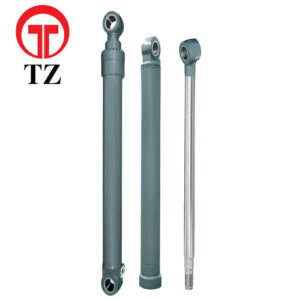An excavator cylinder is a hydraulic component that is used to move and control the movements of the excavator arm, boom, and bucket.
Here are some of the key features and how it works:
Features:
- Typically made of high-strength steel to withstand heavy loads and pressures.
- Consists of two main parts: the cylinder barrel and the piston rod.
- Contains hydraulic fluid, which is pressurized by a hydraulic pump to provide the necessary force for movement.
- Can have various types of seals to prevent leaks and maintain pressure.
How it works:
- The hydraulic pump sends pressurized hydraulic fluid to the cylinder’s hydraulic ports.
- The pressurized fluid pushes the piston inside the cylinder, which in turn moves the piston rod.
- As the piston rod moves, it transfers force to the excavator arm, boom, or bucket, causing them to move.
- The direction and speed of the movement are controlled by the operator using the control valves in the cab.
- The pressure of the hydraulic fluid inside the cylinder is regulated by the relief valve, which prevents the cylinder from being overloaded.
Overall, excavator cylinders play a critical role in the operation of excavators and are essential for moving heavy loads and performing various excavation tasks.
The Characteristics of a excavator cylinder
Excavator cylinders are hydraulic components that have specific characteristics that allow them to perform the necessary functions in excavator operations.
Here are some of the key characteristics of an excavator cylinder:
- Strength and Durability: Excavator cylinders must be made of high-strength materials to withstand the heavy loads and pressures that they are subjected to during operation. They should also be durable to ensure a long service life.
- Precision: Excavator cylinders need to be precise to ensure smooth and accurate movement of the excavator arm, boom, and bucket. The cylinders must be designed and manufactured to precise tolerances to avoid any play or slack in the movement.
- Sealing: Excavator cylinders have various types of seals to prevent hydraulic fluid from leaking out of the cylinder. The seals must be durable, wear-resistant, and able to withstand the high pressures and temperatures of the hydraulic system.
- Corrosion Resistance: Excavator cylinders may be exposed to harsh outdoor environments, which can lead to corrosion. Therefore, they must be resistant to corrosion to prevent damage and maintain the cylinder’s integrity.
- Efficient Performance: Excavator cylinders should have high efficiency to minimize energy consumption and reduce operating costs. They should be designed to minimize friction and pressure drop to maximize the energy transfer to the movement of the excavator arm, boom, and bucket.
Overall, these characteristics are essential for ensuring the proper functioning of excavator cylinders and the overall performance of excavators in various applications.
Large excavator cylinder Sizes in Europe
The sizes of large excavator cylinders in Europe can vary depending on the specific model and manufacturer.
However, here are some general size ranges for large excavator cylinders commonly used in Europe:
- Bore diameter: 100mm to 500mm (3.94 inches to 19.69 inches)
- Rod diameter: 50mm to 300mm (1.97 inches to 11.81 inches)
- Stroke length: 500mm to 5000mm (19.69 inches to 196.85 inches)
It’s important to note that these are approximate size ranges and can vary depending on the specific manufacturer and model of the excavator cylinder. Additionally, there may be custom or specialized sizes available for certain applications.

